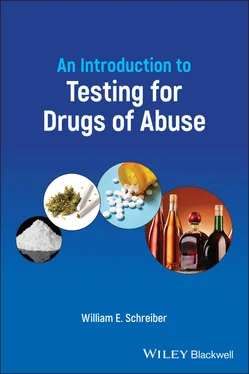Dilution – the goal of this strategy is to dilute drugs in urine below the threshold for a positive result. This can be accomplished in several ways: (i) drinking an excess of fluids prior to collection, (ii) taking diuretics to flush drugs out of the urinary tract, and (iii) adding water or another liquid to the sample itself.
Assessment of specimen validity begins with measuring urine temperature, which should be 90–100 °F (32–38 °C) within 4 minutes of collection. The physical appearance is also evaluated for color and consistency, and any unusual odor is noted.
The following chemical tests are run on patient samples to detect tampering that may give a false result.
| Creatinine |
Creatinine is excreted in urine and serves as a marker for this fluid. Random urine specimens contain at least 20 mg/dL (1.8 mmol/L) of creatinine. Values below this level may indicate a dilute or substituted sample |
| Specific gravity |
This test measures the number of solute particles in urine. The reference range for specific gravity is 1.002–1.030. A low specific gravity may indicate a dilute or substituted sample |
| pH |
Normal human urine has a pH between 4.5 and 9.0. Adulteration of a sample with an acid or base will alter the pH |
| Oxidant |
Tests for oxidants can detect chromate, nitrite, bleach, peroxide, and iodine. Normal human urine does not contain oxidants above the assay cut‐off, and increased values may indicate adulteration |
| Nitrite |
Nitrite is not detectable in normal urine samples, but it may be elevated in patients with a urinary tract infection. High levels of nitrite may indicate an adulterated sample |
| Chromate |
Chromate is an effective oxidizing agent, and it is not normally present in human urine. A positive test suggests that the urine sample has been adulterated |
| Aldehyde |
Glutaraldehyde and other aldehydes are not present in normal human urine. A positive test suggests that the sample has been adulterated |
Interpretation of Specimen Validity Testing
The Substance Abuse and Mental Health Services Administration (SAMHSA) has developed criteria for specimen validity in workplace drug testing programs. Dilute and substituted specimens are identified by comparing the values for creatinine and specific gravity ( Table 3.1). To label a specimen as adulterated, an abnormal pH or the presence of a known adulterant is required ( Table 3.2).
Table 3.1 Substance Abuse and Mental Health Services Administration criteria for labeling a urine specimen as dilute or substituted. a
| Test |
Dilute |
Substituted |
| Creatinine |
≥2 and <20 mg/dL |
<2 mg/dL |
| Specific gravity |
>1.001 and <1.003 |
≤1.001 OR ≥1.020 |
aBoth criteria (creatinine and specific gravity) must be met.
Table 3.2 Substance Abuse and Mental Health Services Administration criteria for labeling a urine specimen as adulterated. a
| Test |
Adulterated |
| pH |
<3.0 |
|
≥11.0 |
| Nitrite |
≥500 μg/mL |
| Chromium (VI) |
Present |
| Glutaraldehyde |
Present |
aAny one criterion is adequate. Depending on how samples are tested, other adulterants may be detected as well.
Table 3.3 Substance Abuse and Mental Health Services Administration criteria for labeling a urine specimen as invalid. a
| pH value ≥3.0 and <4.5 and ≥9.0 and <11.0 |
| Nitrite value ≥200 and <500 μg/mL |
| Inconsistency between creatinine and specific gravity |
| Interference in a screening or confirmatory assay |
| Presence of oxidizing compounds |
| Possible presence of: |
| chromium (VI)halogen (e.g., iodide)surfactant (e.g., soap) |
| Physical appearance of specimen |
aIndividual laboratories may use different or additional criteria.
Specimens can also be deemed invalid in a number of situations ( Table 3.3). An invalid result may indicate specimen tampering, but other explanations are possible. A review of the patient's history and consultation with the laboratory may clarify the situation.
1 Allen, K.R. (2011). Screening for drugs of abuse: which matrix, oral fluid or urine? Ann. Clin. Biochem. 48: 531–541.
2 Bosker, W.M. and Huestis, M.A. (2009). Oral fluid testing for drugs of abuse. Clin. Chem. 55: 1910–1931.
3 Cooper, G.A.A., Kronstrand, R., and Kintz, P. (2012). Society of hair testing guidelines for drug testing in hair. Forensic Sci. Int. 218: 20–24.
4 Dasgupta, A. (2007). The effects of adulterants and selected ingested compounds on drugs‐of‐abuse testing in urine. Am. J. Clin. Pathol. 128: 491–503.
5 Verstraete, A.G. (2004). Detection times of drugs of abuse in blood, urine and oral fluid. Ther. Drug Monit. 26: 200–205.
1 Garg, U. and Cooley, C. (2019). Testing of drugs of abuse in oral fluid, sweat, hair, and nail: analytical, interpretative, and specimen adulteration issues. In: Critical Issues in Alcohol and Drugs of Abuse Testing, 2nd Edition (ed. A. Dasgupta), 405–427. Academic Press.
Technical assistance publication
1 Clinical Drug Testing in Primary Care (2012). HHS Publication No. (SMA) 12‐4668. Rockville, MD: Substance Abuse and Mental Health Services Administration. https://store.samhsa.gov/sites/default/files/d7/priv/sma12‐4668.pdf.
Конец ознакомительного фрагмента.
Текст предоставлен ООО «ЛитРес».
Прочитайте эту книгу целиком, купив полную легальную версию на ЛитРес.
Безопасно оплатить книгу можно банковской картой Visa, MasterCard, Maestro, со счета мобильного телефона, с платежного терминала, в салоне МТС или Связной, через PayPal, WebMoney, Яндекс.Деньги, QIWI Кошелек, бонусными картами или другим удобным Вам способом.












